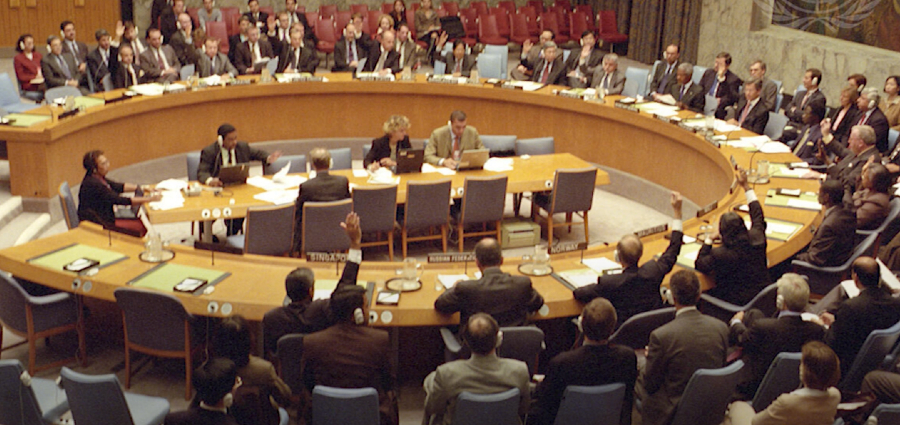The United Nations’ List of 'Not Listed' Terrorist Entities
What does it mean when individuals and groups are included in U.N. terrorism reports but don't make the cut for sanctions?

Published by The Lawfare Institute
in Cooperation With

Editor’s Note: The U.N. Analytical Support and Sanctions Monitoring Team regularly issues highly useful reports on al-Qaeda, the Islamic State, and related movements. The reports identify entities subject to global penalties because of their involvement in terrorism, but they also identify some individuals and groups who are not formally listed. Lauren Fredericks and Matthew Levitt of the Washington Institute for Near East Policy examine this “not listed” category, explaining how U.N. experts are implying that entities on it are also dangerous and that governments should formally designate them.
Daniel Byman
***
In his most recent report to the U.N. Security Council on the threat posed by the Islamic State, al-Qaeda, and their affiliates to international peace, U.N. Secretary-General Antonio Guterres offered a strategic-level overview of these groups as well as an update on the range of U.N. efforts—in support of member states—to counter these threats. As usual, the report—which is based on the work of the U.N. Analytical Support and Sanctions Monitoring Team—is substantive and full of useful data. Breaking down its analysis by region, the report analyzes the evolving threat posed by al-Qaeda, the Islamic State, and associated groups, and how their leaders and other actors fit into the terrorist landscape. Likewise, a similar but separate series of reports, the most recent of which was published in May 2022, analyzes the Taliban and associated entities that threaten the peace and stability of Afghanistan. Individuals and groups that meet the criteria of cooperating with, supplying support to, or receiving support from these entities are included on the U.N. Security Council Consolidated List and subject to asset freezes, travel bans, and arms embargoes.
But the al-Qaeda/Islamic State and Taliban reports (hereafter, “the reports”) are equally important for what they leave out—specifically their notation, per U.N. practice, of terrorist operatives who warrant mention in the reports but who are not included on the U.N. Security Council’s terrorist designation list. Though not collated together in any one list, those 38 persons and 16 groups that are “not listed” comprise a de facto list of terrorist operatives that the U.N. Monitoring Team would like to see designated and signals that U.N. member states should consider collecting more information about them and propose them for designation.
Who Makes the List and Who Is “Not Listed”?
Established in 1999 to impose a limited air embargo and asset freeze targeting the Taliban, U.N. Security Council Resolution 1267 created what would become the Consolidated List. In 2011, new resolutions (Resolutions 1988 and 1989) split the list into two, one focused on al-Qaeda and the other on the Taliban, with each submitting separate, biannual reports on the global threats posed by each group and its networks. The Consolidated List was expanded to include the Islamic State in 2015 (Resolution 2253), at which time the Monitoring Team expanded the scope of its reports focused on al-Qaeda to include the threat posed by the new splinter group. In 2021, Resolution 2610 reaffirmed the asset freeze, travel ban, and arms embargo authorities targeting entities on the Islamic State and al-Qaeda sanctions list.
The secretary-general’s February 2022 report on al-Qaeda and the Islamic State, the 14th of its kind, is not the first to point out when individuals mentioned in the report do not appear on the Security Council’s terrorism designation list. These biannual reports are prepared by the U.N. Monitoring Team, the U.N. Counter-Terrorism Committee Executive Directorate, and the U.N. Office of Counter-Terrorism, in cooperation with others. The information in the reports comes from member states that share information with the Monitoring Team. But the Monitoring Team has two distinct functions—assisting the Sanctions Committees with the maintenance of the U.N. sanctions lists and providing regular assessments of the terrorist threats to international peace and security—and member states typically focus their briefs to the Monitoring Team solely on the matter of the threat assessment. These member states mention individuals whose activities warrant inclusion in the threat assessments, but, with the exception of the United States and a handful of other countries, they rarely consider proposing these people for designations. Indeed, some member states would likely refuse to speak to the Monitoring Team if these briefings focused primarily on identifying sanctions targets. The reasons for this reluctance vary but relate to concerns about sanctions regimes. Objections include the view that the effectiveness of sanctions remains inconclusive, or that they disproportionately focus on a particular region (an objection often raised by African countries), or that they have been politicized by geopolitical rivals (as has been argued by India and Pakistan).
As a matter of U.N. practice, when a designated individual is mentioned in the report, the individual’s designation number is included in parentheses. Nondesignated individuals who are tied to the Taliban, al-Qaeda, or the Islamic State are categorized as “not listed” unless the individual in question is deceased. However, while the designation number of designated groups is mentioned, by U.N. practice the reports do not point out those groups that are not designated (that is, they are not categorized as “not listed”). For its part, the U.N. Monitoring Team has no investigative authorities and cannot propose individuals or groups for listing—but it can draw greater attention to them. According to one counterterrorism official involved in this process with whom we discussed this issue, the practice of noting when terrorists referenced in the report are not included on the Consolidated List is intended to suggest to member states that the individual in question is worth investigating further and possibly proposing for designation. It aims to try to extend ownership and responsibility for maintaining and updating the U.N. sanctions lists to a wider group of member states than just the United States and other Western allies.
The criteria for adding an entity to the Islamic State and al-Qaeda list or the Taliban list are clear and include:
- participating in the financing, planning, facilitating, preparing or perpetrating of acts or activities by, in conjunction with, under the name of, on behalf of or in support of;
- supplying, selling or transferring arms and related materiel to;
- recruiting for; or
- otherwise supporting acts or activities of ISIL (Da’esh), Al-Qaida, or any cell, affiliate, splinter group or derivative thereof … [or, for the Taliban: “individuals, groups, undertakings, and entities associated with the Taliban in constituting a threat to the peace, stability, and security of Afghanistan”].
Any individual or group worth mentioning in the reports would presumably qualify for listing under these criteria, given that they are included precisely because of their ties to the Islamic State, al-Qaeda, the Taliban, or a related group. So when the reports highlight that some are “not listed,” it is a not-so-subtle indicator that perhaps they should be added in the near future. In some cases, like the new leader of the Islamic State, the cited persons are sure to be listed in the near future. Some cases are heavily politicized among member states, which is how the current head of the Taliban, Hibatullah Akhundzada, somehow never made it on the U.N. list of designated Taliban officials. In still other cases, the Monitoring Team may have enough data to include individuals in a report but not enough data to list them outright. For example, Tanzanian national Abu Yasir Hassan is included in February’s report as the leader of Ahlu Sunna Wal Jama, or ISIS-Mozambique, but Tanzanian authorities have no record of an individual by this name. In cases such as these, it seems the U.N. report is a subtle nudge to member states to collaborate with one another and collect the necessary information to support such action. And while unlisted groups are not noted in the reports as “not listed,” the fact that their names appear in the reports but are not followed by their designation number makes it clear that they are not yet listed and likely should be. It is also worth noting that this is a rapidly evolving list—multiple terrorist actors marked as “not listed” in the secretary-general’s February 2022 report have been killed in ongoing hostilities in the few months since the report’s release.
Below, we have identified a dozen of the most seemingly obvious and well-documented individuals and organizations noted in the secretary-general’s February 2022 al-Qaeda and Islamic State report or in the May 2022 Taliban report that do not yet appear on the U.N. terrorism designation list.
The “Not Listed” Dirty Dozen
- Sami Jasim Muhammad al-Jaburi
Currently in Iraqi custody, Sami Jasim Muhammad al-Jaburi (who also goes by the alias Hajj Hamid) was considered the most senior deputy of now-deceased Islamic State caliph Abu Ibrahim al-Hashimi al-Qurashi. Jaburi previously served as the chief for the Islamic State’s sharia council and operated as the group’s “second in command” in southern Mosul. One U.N. Security Council member state has asserted that Jaburi currently oversees the Islamic State’s coordination with its external provinces.
- Meddie Nkalubo
Ugandan citizen Meddie Nkalubo (“The Punisher”) works with the Democratic Republic of the Congo’s Islamist rebel group, the Allied Democratic Forces (ADF), and has distributed Islamic State propaganda and instructional videos throughout the region. Nkalubo has served as a bombmaker and the coordinator of the ADF’s domestic terrorist operations since August 2021, and he has been implicated in an October 2021 suicide bus attack and the November 2021 triple suicide bombings in Kampala, Uganda, which killed three people and injured 33 others.
- Abdul Bara al-Sahraoui
Abdul Bara al-Sahraoui (alias Abdul Bara al-Ansari; Abu Omarou) replaced Islamic State in the Greater Sahara (ISGS) leader Adnan Abu Walid al-Sahraoui (who is included on the Security Council’s Consolidated List) in October 2021. Since then, ISGS has been connected to a massacre in a remote village in southwestern Niger that killed 69 people in November 2021.
- Khalid Batarfi
The Security Council report describes al-Qaeda in the Arabian Peninsula (AQAP) leader Khalid Batarfi as “a rising second-generation leader of Al-Qaida.” Following the U.S. recognition of Jerusalem, Batarfi commanded Muslims to “rise and attack the Jews and the Americans everywhere.” During Batarfi’s tenure as emir, AQAP militants detonated a bomb that destroyed a health center in al-Bayda province, and Batarfi appeared in two AQAP videos in which he comments on the group’s efforts to ready itself for attacks targeting the West.
- Hibatullah Akhundzada
Taliban supreme leader Hibatullah Akhundzada has provided al-Qaeda with a “safe haven” and greater freedom of movement since his group seized power in Afghanistan. Under his command, the Taliban have killed more than a hundred former officials, banned girls’ education, and allowed the Tehrik-e-Taliban Pakistan to use Afghanistan as a launching pad for attacks targeting Pakistan.
- Osama Mehmood
Osama Mehmood is the former spokesperson and current leader of al-Qaeda in the Indian Subcontinent, a branch set up by al-Qaeda leader Ayman al-Zawahiri in 2014. Mehmood’s fighters appear to be integrated into Taliban units, including those with an operational role during the Taliban’s takeover of Afghanistan.
- Katiba Macina
Jama’a Nusrat ul-Islam wa al-Muslimin (JNIM) affiliate Katiba Macina operates in central Mali. Its leader, Amadou Koufa, is included on the Consolidated List and is considered one of the top deputies to JNIM leader Iyad ag Ghali. In December 2021, Katiba Macina ambushed a public bus near the Malian village of Songo, killing 32 civilians.
- Ahlu Sunna Wal Jama
Ahlu Sunna Wal Jama (ASWJ, also known as ISIS-Mozambique, or locally as al-Shabaab in Mozambique) is believed to have pledged bayat to the Islamic State as early as April 2018, with the Islamic State’s core leadership acknowledging it as an affiliate in August 2019. The group has killed more than 1,300 civilians and displaced nearly 670,000 persons since October 2017. ASWJ cells are known to plunder villages and behead civilians, and the group commonly kidnaps young girls to be sex slaves and young boys to be child soldiers. In November 2020, ASWJ fighters beheaded more than 50 people in northern Mozambique.
- Ansar Bayt al-Maqdis (ABM)
Ansar Bayt al-Maqdis (ABM, or ISIS-Sinai Province) pledged bayat to the Islamic State in 2014 and has since been acknowledged as an affiliate and prominently featured in Islamic State propaganda. The most recent ABM attack occurred in May 2022, when ABM militants attacked a checkpoint at a water-pumping station east of the Suez Canal and killed 11 Egyptian soldiers.
- Hurras al-Din
Though the Security Council report assesses that al-Qaeda affiliate Hurras al-Din’s (HAD) “long-term viability may be in question,” it nonetheless confirms that HAD claimed around 200 attacks. In June 2020, HAD oversaw the merger of an al-Qaeda-affiliated military operations room known as Fa’ithbitu, and the group has dispatched some of its members to form cells near Dar’a and Suwayda’.
- Ansarul Islam
Northern Burkina Faso-based group Ansarul Islam offers support to al-Qaeda affiliates Katiba Macina and Katiba Gourma. As of March 2018, at least 78 attacks in northern Burkina Faso were attributable to Ansarul Islam, and there have been documented cases of JNIM sending its operatives to train Ansarul Islam militants.
- Ba Koura
The Ba Koura splinter group, which pledged bayat to Boko Haram leader Abubakar Shekau in September 2019, operates in the Lake Chad region. In March 2020, the group led an attack on a Chadian garrison that killed almost 100 soldiers. Ba Koura has also been linked to the massacre of several dozen fishermen on Darak Island on Lake Chad.
Looking Toward the Next Report
The 12 individuals and groups described above have terrorized civilian populations and demonstrated close ties to al-Qaeda, the Islamic State, the Taliban, or a related group. They exemplify the most clear and obvious examples of terrorist entities that unequivocally meet the requirements necessary for listing. The secretary-general’s next biannual report to the Security Council on al-Qaeda and the Islamic State is being drafted now and is expected to be released in July 2022. Member states were given ample notice in the February 2022 report of the persons and groups noted here, among others, that should likely be on the U.N. list but were not included at the time. Hopefully several will have been added by the time the secretary-general issues his 15th report to the Security Council in July.






